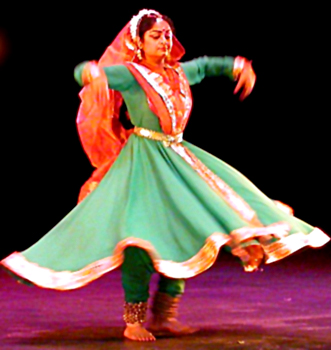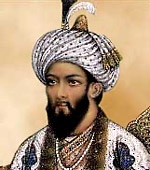 Islamic influence was visible in the miniature paintings of that time. Due to Muslim influence there was a wide transformation in Hindu Art and cultural activities. Sufi created the spirit of tolerance. Muslim influence brought music out of the temples into the courts and chambers of royal families. Some of the Muslim Mughal rulers, who loved music and helped it grow, enriched North Indian music by incorporating Persian elements. New types of music like the Khayal, Thumri and Tarana were introduced.
Islamic influence was visible in the miniature paintings of that time. Due to Muslim influence there was a wide transformation in Hindu Art and cultural activities. Sufi created the spirit of tolerance. Muslim influence brought music out of the temples into the courts and chambers of royal families. Some of the Muslim Mughal rulers, who loved music and helped it grow, enriched North Indian music by incorporating Persian elements. New types of music like the Khayal, Thumri and Tarana were introduced.
Influence of Muslim Rule on Dance
There was an evolution of a new type of dance called the Kathak. The art was not pursued purely from an aesthetic view point. The kings and the Rajas either encouraged dissolute practices or were indifferent and so it became a prisoner in the hands of the professional pimp and the courtier. This was the scene both in the reigns of the Sultans and the Mughals.
Influence of Muslim Rule on Music
In music however India reached great heights during this period. The orthodox Muslims had contact with Iran and development of Sufism with its religious fervour expressing itself in dance and music made the Muslims appreciate music. In India contact with the music-loving Hindus further encouraged the growth of music among the Indian Muslims. The Sultans had a regular company of musicians and instrumental performers. Khusro was both a singer and a dancer. Jalal-ud-din Khilji was a musician and also used to dance with his companions. Firoz Tughlaq was also a patron of music. In the provinces also the art was highly appreciated. Hussain Shah Sharqi of Jaunpur invented Khayal. Music flourished in the age of the Sultanate and there was interaction between the Muslim and the Hindu music producing fresh melodies.

The Mughals were patrons of music and in their rule it attained great perfection. Babar was well-versed in it and one of the classes of society mentioned by Humayun was Ahl-i-murad, consisting of musicians and dancers. Akbar took special delight in music and song, and had a considerable knowledge of the technicalities of those arts. Tansen was universally recognised as the premier musician of the age. In Akbar`s court there were more than thirty musicians. There were Persian and Indian musicians. There were a number of instrumental performers like Ustad Dost Mohammad, Bahram Quli and Qasim. In later reigns, however, there was a revival and there were numerous families of music. During this period instrumental music was also cultivated and new instruments like the sitar and tabla were introduced. Cultivation of music brought the two communities together and fostered national unity.
Influence of Muslim Rule on Painting
The art of painting did not receive the attention and encouragement which the other arts did receive at the hands of the early Muslim kings of India. This was mainly because it was a tabooed art on account of its close association with idolatry. Hindus embracing Islam had spread it and the Mughals brought it from Persia. Babur brought choicest specimen from the library of his ancestors Timurids and was also inspired by Bihzad. This art was manly and vigorous; scenes of battle, sieges and gladiatorial combats predominated. There were romantic and mystical themes also. Emperor Humayun brought from Persia two master-painters of the Neo-Persian School. Akbar founded and endowed a State Gallery where painters came from far and wide to emulate one another. The mural decorations of Fatehpur Sikri are splendid specimen of the art of painting. Jahangir was the Prince of Artists.
Mughal painting consists entirely of book illustrations and portfolio pictures and they are called miniatures. It is a courtly and aristocratic art, realistic and romantic, secular and quite remote from folk-sentiment. It is interested in individual character, and the splendid ceremonial of court life. Its keynote is portraiture and actual likeness. The elements in the painting were derived from Bukhara and Samarquand. Some Persian and European elements also entered. It has an individuality of its own and also takes some features of the Rajput art, for example the moonlit terrace is Rajput. Mughal painting was a purely artificial product of the court and the connoisseurs.



















